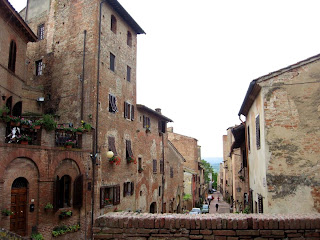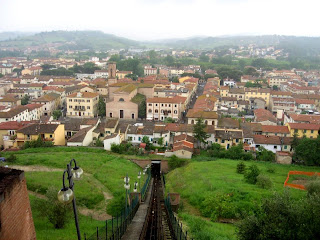Friday 14th May 2010, Siena, Tuscany
By 7.30am this morning we had left the port of Livorno behind and were driving through heavy rain along the valley of the Arno with flooded fields to either side. The rain eased as we turned off onto more rural roads and the pretty countryside of Tuscany spread out in rolling fields around us. There is so much grass and so many trees in bright green leaf. Gone are the palm trees, agaves and cactuses. Here we have oaks, chestnuts and acacias while the long grass is full of bright wild flowers. There are thousands of poppies in the fields and along the roadsides. We passed through avenues of huge green plane trees and beside the road, in folds in the hills or on high rounded green hills we could see large brown villas with green or rust-coloured shutters that blend so perfectly with the landscape they actually add to its perfection. It is all such an incredible contrast to the recently visited ugly, soulless towns of Eastern Sardinia that so scarred the countryside.
This evening, as we recover from two days without any real sleep, we feel that we have seen more beautiful towns, buildings, paintings and soft, gentle countryside than we have experienced over the past six weeks. Two people, starved of culture and artistic beauty, have gorged themselves silly on it today! We've seen three stunning Italian towns, none of which we knew about, all by chance. They simply happened to be along the route we were following towards Siena.
By 8.30am we needed to stop for a walk around, coffee and something for breakfast. Passing through Certaldo we parked near the main square and discovered a little funicular railway which carried us up a steep hillside and straight into the old mediaeval walls of the stunning ancient brick and stone town.
We wandered open mouthed, through streets of houses dating back to the 14th century, their coats of arms above the doors.





It was here that the 14th century poet Boccaccio, author of the Decameron, spent his later life and died. He is buried in the church and his home is now a museum.


Also in the same church we found the skeletal remains of the blessed Giulia da Certaldo. She died in 1367 and is honoured by the town. In the bizarre manner common in Italy her remains have been clothed in rich robes and placed in a glass case on one side of the church interior.

Brick ages so well, more recent restoration work on buildings such as Boccaccio's house blending easily with the original walls. From the protective brick ramparts surrounding the town we could look down onto the streets of the more recent lower town and out across the green countryside.
Refreshed by coffee and delighted with our stroll through the streets we continued to the 14th century town of San Gimignano. This is a far larger place and a popular visitor destination. The mediaeval streets of the town were thronging with tourists. Here we found very many Americans - we'd seen none in Sardinia. They obviously know how to pick the very best from Europe during their precious, brief vacation! The spotless streets are lined by mediaeval palaces and the houses of the nobility. It's absolutely perfect.
The small city is surrounded by tall ramparts built in brick with fourteen tall "towers of nobility". Originally there were seventy two. They were built by wealthy residents to protect themselves in times of riot and local disturbance between warring families within the city. For reasons of prestige each noble tried to build a higher tower than his neighbour.



The cathedral overlooks the main square. We didn't look inside as there was far too much to see around the streets and in the warm sunshine it was so very agreeable to join with all the other nationalities eating slices of pizza sitting on the steps of the cathedral! Such glorious mediaeval and renaissance cities are outdoor museums where the visitor wanders the streets feasting on architectural eye candy.

We did though go into the 13th century church of Sant'Agostino, with its seventeen late 15th century frescoes by Benozzo Gozzoli on the life of Saint Augustine.



In some ways San Gimignano was just too perfect and visitors too well catered for with specialist restaurants and souvenir shops. The streets were crowded even this early in the year. The next little town we visited though, while also being very lovely, was not on the tourist trail and had more the feel of a town still living its every day existence rather than a living museum.
We liked Colle de Valle d'Elsa from the very first moment. Stretched along the top of a ridge, the brown walls of its ancient buildings with their rounded orange tiles have been weathered, bleached and faded by centuries of sunshine. Anywhere there is a shady corner, pots of aspidistras have been placed. The cobbled streets are swept clean and steep flights of steps or cool alleyways link the different parts of the ancient town. Some of the houses had been decorated in black and white sgraffito work where the pattern is scratched into the wet plaster.



We even discovered an entire underground street with front doors opening into the dark passage way. People have been walking through it for hundreds of years and the same brackets that originally held flaming torches to light the way are still present!

The sound of chanting lead us down a flight of steps to the funeral chapel beneath the Cathedral. The walls and ceilings were painted with frescoes in which skulls and crossbones figured prominently, there were black drapes everywhere and beyond a screen, hidden from view, monks were chanting a funeral mass.


In the Cathedral above we found a beautiful renaissance baptismal font and a 14th century lectern.



On the Cathedral piazza was a statue of the town's most famous son, Arnolfo di Cambio 1230-1301, architect of Florence Cathedral.

From the walls of the town we could look down onto the surrounding countryside of vineyards, olives, green fields and woodland. To end our visit we sat in the warm sunshine of late afternoon looking up at one of the towers of the city walls licking delicious Italian ice creams. They are the best in the world!

From Colle de Valle d'Elsa we drove along winding roads across empty countryside towards Siena, through a verdant landscape with vegetables, fruit trees and vines growing on a deep red soil after which the artist's colour is named. (It also happens to be the very same colour as the Devon red around Exeter back in England.)

